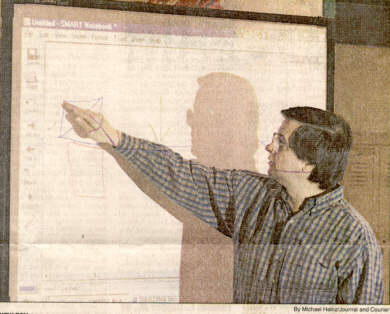
Electronic Whiteboards -They Offer New New Possibilities... but also New Challenges
A recent newpaper article focused on the possibility that electronic whiteboards will allow teachers to save to computer files the handwriten chalkboard notes that formerly were lost when the board was erased. The article mentioned that one teacher e-mails the notes to students who were absent that day.

A point not made in the article was that the electronic boards are typically 5 ft wide, whereas teachers are used to working on chalkboards or whiteboards that are 20 ft wide. This means that with traditional boards there was plenty of room for the teacher to write large...and step to one side so that students could see what was written.
When the board is only five feet wide, the teacher is more likely to write smaller to fit the space... and there's a greater tendency to stand in front of the images (see newspaper picture above). Both contribute to students not being able to see important data.
Additionally, the obvious advantage of being able to project and manipulate computer text on the whiteboard is again offset by the fact that a five foot wide screen limits legibility of 80 character computer text to kids who are no more than 15-20ft away... when many classrooms are 25-35 feet deep. And, since the board must be low eneough for the teacher to electronically write on it, it is then too low for the kids to see the bottom third of the text if they aren't in the first row. This will usually mean having a single row of students, or having bankers for a second row of students.
Remember, as the teacher right next to the board, you can see images
perfectly.
To know what your students can see, sit in furthest student seat (with the seats in front of you
occupied by people your size), and adjust the seating accordingly, or move to a bankered room.
Have a question about classroom design, or a good idea? E-mail:

ClassroomDesignForum.org is listed by the National Clearing House for Educational Facilities (NCEF)